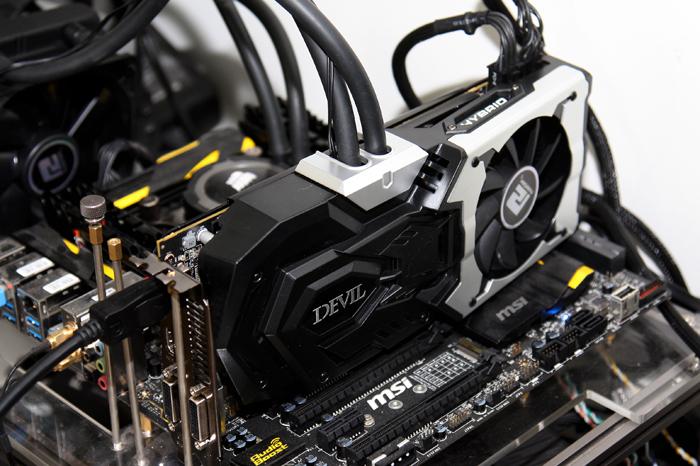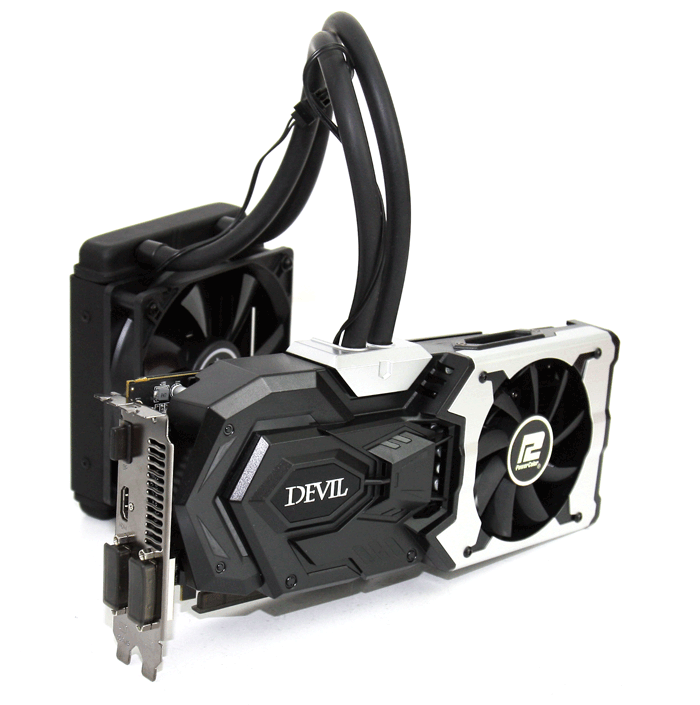Final Words & Conclusion
Final Words & Conclusion
Compared to the Devil 13 release (Dual GPU 290 and recent 390) I feel that this R390X Devil edition is a bit lost in product placement? First and foremost, I do not know one AMD customer that hasn't already bought a R9 290(X) in the past two year or so, these guys will definitely not upgrade to the same GPU with a tad more memory which they don't use 99% of the time anyway. Secondly, and don't get me wrong here as the tweaking and cooling remains impressive, the look and feel of the DEVIL card I find a bit too well ... let's call it plastic ? I am just not sure how well the design sits with the most of you guys. PowerColor will probably flip the finger to me for saying this and sure, it is a personal opinion of course. I'd love to hear what you guys thing about it though, let me know in the forum thread on this article. That said, the Radeon R9 390X remains to be a potent card, the Catalyst 15.7 and later drivers seem to have boosted performance for the 390 series overall a little further, but let's be honest here and call the card what it really is, the 290 series with the very same characteristics, the same number of shader processors and, well, same everything. It is the latest iteration of the ASIC that allows for slightly higher clocks overall. The differences are to be found merely in the GPU clock frequency which is up 100 MHz over a reference 290X. The memory is clocked faster at an effective data-rate of 6.1 GHz. The most substantial noticeable gain is a move from 4 towards 8 GB of graphics memory. We doubt the benefits from the extra 4GB, the number of scenarios where you will pass 4GB is extremely limited.
Cooling & Noise Levels
The reference Hawaii GPU cooled products in the 290 reference series were to be considered really average at 95 Degrees C, the air cooled 390X cards all hover in the the 83 Degrees C marker depending on the airflow inside your system and the ambient temperature. The DEVIL Hybrid cooling does its job well, at just over 50 Degrees C on the GPU, hey that's liquid cooling for you. Nice to see is a metal plate at the backside of the card so the card cannot bend when seated horizontally in the PC. However there should be way more gaps holes and meshes on that back-plate. The noise levels are OK but just that. You can hear the card in full stress but remains at acceptable noise levels.
FLIR Thermal imaging
Yeah, you missed them right ? Our thermal image camera is in RMA, the SD card slot is broken hence we cannot include thermal images at this time.
Power consumption
Power consumption is not bad but again not good either. The card is rated by us having roughly a 307 Watt peak power consumption (average is lower). That is significant, but could have been worse. The higher GPU voltage and the liquid cooler simply eat away a few more Watts. I think enthusiast consumers at this performance level will not mind that much about the power draw and be forgiving. That TDP will make running multi-GPU solutions a bit more complicated. With two cards we think an 800~900 Watt PSU would be sufficient. So yeah, it's not great to have a GPU consuming that much power, again it could have been a lot worse.
Performance & drivers
Any Radeon R9 390X in most scenarios will be performing roughly at GeForce GTX 980 and Titan like performance, if priced right that is a pretty okay position to be in. Performance wise all modern games up-to 2560x1440 will run pretty good, and that is at the good image quality settings. For Ultra HD the 8 GB comes in handy, then again one card is not powerful enough to drive that resolution for gaming with high image quality settings and proper AA levels. What I am trying to say is that the 8GB graphics memory is nice and welcome, but might be a little irrelevant for most end-users while you do pay a price premium for it.
Overclocking
Overclocking then, this card is already factory overclocked for you and you get to add a little extra, but sure, it's not heaps alright. You can reach roughly 1200 MHz on the GPU stable, though that was the best we could reach. The memory can be clocked to roughly 6700 MHz (effective). Overall that brings the card another 5, maybe 10% performance when compared to reference clock frequencies depending on game title/resolution. It is a reasonable tweak.
Concluding
The PowerColor DEVIL that is bound to please some for the sheer fact that it is liquid cooling that GPU. The overall noise levels are OK, the cooling performance obviously is excellent. The looks as previously mentioned remain trivial, but are subject to personal preference. We do have mixed feelings about AMD re-spinning GPUs on this scale. It's not just AMD though, Nvidia as well - yet not to this extent. Honestly I do not know how long both AMD & Nvidia can get away with it, in the end the likelihood of people already owning a product based on old tech, in this case Hawaii, is substantial. So why upgrade if you already own a near similar product? And herein lies the core problem of declining sales for AMD board partners. And it's that sentiment that can spiral down their graphics card sales significantly. The opposing fact remains we also need to weigh in the fabrication process issues, 20nm manufacturing nodes have failed. The industry is moving forward to 14nm. And until that happens, where fabrication node GPU wise is yielding properly, we might as well get used to this I guess. So I understand the respins and the reasoning behind it, I'm just not sure how the end-users will benefit from it. For the 390X, the differences in-between the 290 series and the product tested today are rather small. Let's also not forget that there already have been 8GB R9 290X graphics cards on the market for almost a year. The extra 50 to 100 MHz on the GPU isn't going to move mountains and the extra kick in bandwidth on the memory isn't going to make the biggest difference either, as the card already had plenty of bandwidth. So from that point of view, I think the 390 series is going to be a hard sell. Everybody that has a preference for team red already has a R9 series 290 card, as such the one big difference remains to be the extra 4GB of memory, and yeah, here again I feel that it is not gonna make a big difference for most people. But perhaps I am wrong, who knows.
PowerColor has an original offering, I mean very original .. one look at the photo above and you will understand that the concept is out of the box thinking with a unique design. The end result is a product that offers great cooling temperatures for a Hawaii/Grenada based GPU combined with normal noise levels. Then there are the looks and a small factory overclock. While we like the total of 8 GB graphics memory, 4 GB really already is sufficient in its 2560x1440 monitor resolution domain. In conclusion, the DEVIL ticks most boxes and as such can be recommended if you are in the market for a product like this. Then again we don't see many consumers upgrading to a product that shares 95% of the DNA of a product they already own. We give PowerColor and A+ for originality and thinking out of the box though, hence we give it a Guru3D seal of approval. The PowerColor Radeon R9 390X DEVIL is a unique product, though we think it will be a hard sell in the current market - The card is available at a 499 USD price point.
Recommended Downloads
Sign up to receive a notice when we publish a new article
Or go back to Guru3D's front page




